Mexico City International Airport
| Mexico City International Airport Aeropuerto Internacional de la Ciudad de México | |||||||||||||||||||||||
|---|---|---|---|---|---|---|---|---|---|---|---|---|---|---|---|---|---|---|---|---|---|---|---|
 | |||||||||||||||||||||||
|
Mexico City Airport Terminal 2 | |||||||||||||||||||||||
| IATA: MEX – ICAO: MMMX | |||||||||||||||||||||||
| Summary | |||||||||||||||||||||||
| Airport type | Public | ||||||||||||||||||||||
| Owner | Grupo Aeroportuario de la Ciudad de México | ||||||||||||||||||||||
| Operator | Aeropuertos y Servicios Auxiliares | ||||||||||||||||||||||
| Serves | Mexico City, Mexico | ||||||||||||||||||||||
| Location | Venustiano Carranza, D.F. | ||||||||||||||||||||||
| Hub for |
| ||||||||||||||||||||||
| Focus city for |
| ||||||||||||||||||||||
| Elevation AMSL | 7,316 ft / 2,230 m | ||||||||||||||||||||||
| Coordinates | 19°26′10″N 099°04′19″W / 19.43611°N 99.07194°WCoordinates: 19°26′10″N 099°04′19″W / 19.43611°N 99.07194°W | ||||||||||||||||||||||
| Website |
www | ||||||||||||||||||||||
| Map | |||||||||||||||||||||||
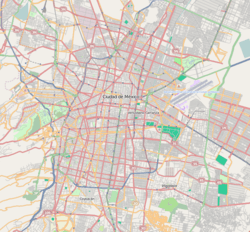 MEX Location within Mexico City | |||||||||||||||||||||||
| Runways | |||||||||||||||||||||||
| |||||||||||||||||||||||
| Statistics (YE Sep '16) | |||||||||||||||||||||||
| |||||||||||||||||||||||
Mexico City International Airport (Spanish: Aeropuerto Internacional de la Ciudad de México, AICM); officially Aeropuerto Internacional Benito Juárez (English: Benito Juárez International Airport) (IATA: MEX, ICAO: MMMX) is an international airport that serves Greater Mexico City. It is Mexico's busiest and Latin America's second busiest airport by passenger traffic; and it is both Mexico's and Latin America's busiest airport by aircraft movements. The airport sustains 35,000 jobs directly and around 15,000 indirectly in the immediate area.[1] The airport is owned by Grupo Aeroportuario de la Ciudad de México and operated by Aeropuertos y Servicios Auxiliares, the government-owned corporation, which also operates 22 other airports throughout Mexico.[5] In recent years Toluca Airport has become an alternate airport.[6]
This hot and high airport is served by 30 domestic and international passenger airlines and 17 cargo carriers. As the main hub for Mexico's largest airline Aeroméxico (with Aeroméxico Connect), the airport has become a SkyTeam hub. It is also a hub for Aeromar, Interjet, Volaris and a focus city for VivaAerobus. On a typical day, more than 100,000 passengers[4] pass through the airport to and from more than 100 destinations on three continents. In 2015, the airport handled 38,433,078 passengers, a 12.2% increase compared to 2014.[7] For the 12-month period ending May 31, 2016 the airport handled 39,563,710 passengers.
Operating at the limits of its capacity,[8] the airport will be replaced by a new Mexico City international airport, announced in September 2014, to be built about 16 kilometres (9.9 mi) north-northeast of the current airport, east of Ecatepec.[9][10]
Location
Located at the neighborhood of Peñón de los Baños within Venustiano Carranza, one of the sixteen boroughs into which Mexico's Federal District is divided, the airport is 5 km (3.1 mi) east from Downtown Mexico City and is surrounded by the built-up areas of Gustavo A. Madero to the north and Venustiano Carranza to the west, south and east. As the airport is located on the east side of Mexico City and its runways run southwest-northeast, an airliner's landing approach is usually directly over the conurbation of Mexico City when the wind is from the northeast. Therefore, there is an important overflying problem and noise pollution.[11][12]
History
.jpg)

Origins
The original site, known as Llanos de Balbuena, had been used for aeronautical activities since 1910, when Alberto Braniff became the first to fly an aeroplane in Mexico, and in Latin America.[13][14] The flight was onboard of a Voisin biplane. On November 30, 1911, President Francisco I. Madero, was the first head of State in the world to fly onboard of a Deperdussin airplane piloted by Geo M. Dyott of Moisant International.[15][16] In 1915 the airport first opened as Balbuena Military Airport with five runways. Construction of a small civilian airport began in 1928. The first landing was on November 5, 1928, and regular service started in 1929, but was officially inaugurated on May 15, 1931. On July 8, 1943, the Official Gazette of the Federation published a decree that acknowledged Mexico City's Central Airport as an international airport, capable of managing international arrivals and departures of passengers and aircraft. Its first international route was to Los Angeles International Airport operated by Mexicana. Construction of Runway 05D-23I started six years later, as well as new facilities such as a platform, a terminal building, a control tower and offices for the authorities. The runway started its operations in 1951. On November 19, 1952, President Miguel Alemán opened the passenger terminal, which later became Terminal 1.[17]
In 1956 the airport had four runways in service: 05L-23R (2,720m long, 40m wide), 05R-23L (3,000m long, 45m wide), with electric lights for night-time service; 13-31 (2,300m long, 40m wide) which had been built to relieve 14-32, to which residential areas had encroached too closely; and 5 Auxiliar (759m long).[18]
1960s–1990s
On December 2, 1963, Walter C. Buchanan, former director of the Transport and Communications Department (SCT), changed the airport's name "Aeropuerto Central" (Central Airport) to "Aeropuerto Internacional de la Ciudad de México" (Mexico City International Airport).[19]
In the 1970s, president Luis Echeverría closed the two remaining shorter runways (13/31 and 5 Auxiliar); on the land of 13-31 a social housing complex was built, Unidad Fiviport.[20][21][22] leaving the two parallel runways. In 1980, the terminal was expanded to double its capacity, using a single large terminal rather than multiple terminals as in other airports. Ten years later in 1990, the mixed domestic/international gates were separated to increase the terminal's functionality, along with the separation of domestic and international check-in halls.
On November 24, 1978, the "Mexico" Control Tower began its operations; it has been in service since then.[19]
The AICM has continually improved its infrastructure. On August 15, 1979, and after about a year of remodeling works, the terminal building reopened to the public; the airport continued its operations during the renovation, which improved passenger transit with better space distribution in walkways and rooms.[23]
Due to constant growth in demand of both passengers and operations, on January 13, 1994, the Official Gazette of the Federation, published a presidential decree that prohibited general aviation operations in the AICM, which were moved to Toluca International Airport in order to clear air traffic in the capital's airport.[24]
Renovations to the AICM continued and on April 11, 1994, a new International Terminal building was ready and operational. It was built by a private contractor according to a co-investment agreement with Airports and Auxiliary Services. In 2001, in order to further improve service to passengers, construction for Module XI started. This Module permitted eight new contact positions in the Airport Terminal, capable of receiving eight regular airplanes, two wide-body, or four narrow-body aircraft.[25]
2003–2007 expansion
Because of the increasing traffic, president Vicente Fox announced the construction of a new, larger airport on 5,000 ha (12,000 acres) in the municipalities of Texcoco and San Salvador Atenco, but when local violent protests took place in 2002, the new airport was cancelled.[26] Instead, to respond to the growing demand and aiming to position the AICM as one of the greatest in terms of quality, services, security, and operational functionality, on May 30, 2003, the Federal Government announced an update: an extension to the air terminal in order to widen its service capacity from 20 million to 32 million passengers a year. This program was part of the Metropolitan Airport System, promoted by the Federal Administration. The Communications and Transportation Ministry (SCT), Aeropuertos y Servicios Auxiliares (ASA) and AICM performed expansion and remodeling work on Terminal 1, over a surface area of 90,000 square metres (970,000 sq ft); 48,000 of which were new construction and 42,000 of which were remodeled. The renovations include new airline counters, commercial spaces and an elevator for people with disabilities, which improved the flow of passengers with domestic destinations.
Among other works performed in the international area, a long-distance bus terminal was built with connections to Puebla, Cuernavaca, Pachuca, Toluca, Querétaro and Orizaba. The new bus station has access to a food court and the international arrivals and departures area, as well as a pedestrian bridge that connects to "The Peñón de los Baños" neighborhood.
The airport was formally named after the 19th-century president Benito Juárez in 2006.[27]
On November 15, 2007, Terminal 2 was opened, significantly increasing the airport's capacity. All SkyTeam members moved their operations to the new terminal, except Air France and KLM. It was officially inaugurated in March 2008, once the new road accesses and taxiways were finished. Terminal 2 increased the airport's contact positions by 40% and the operational capacity by 15%. The terminal was inaugurated by former President Felipe Calderón Hinojosa.[28]
Lack of capacity and slot restriction


The airport has suffered from a lack of capacity due to restrictions on expansion, since it is located in a densely populated area. In 2014, Mexican authorities established and declared a maximum capacity of 61 operations per hour with a total of 16 rush hours (7:00 –22:59).[29] Another issue with the airport is the limitation that its two runways provide, since they are used at 97.3% of their maximum capacity, leaving a very short room for new operations into the airport. Only government, military, commercial, and specially authorized aircraft are allowed to land at the airport. Private aircraft must use alternate airports, such as Lic. Adolfo López Mateos International Airport in Toluca, General Mariano Matamoros Airport in Cuernavaca, or Hermanos Serdán International Airport in Puebla.[30]
Some analysts have reported that if the airport had grown at the same speed as demand, it would have served over 40 million passengers annually by 2010. Even with the inauguration of the new Terminal 2 in 2007, the airport would be ideally designed to serve around 18 million passengers per year, according to international standards for runway and terminal usage. Instead, the airport has increased the number of passengers from around 26 million passengers in 2008 to almost 39 million in 2015, at a rate of 16% per year.[31]
New airport

The construction of a new Mexico City international airport was announced by Mexican president Enrique Peña Nieto on September 2, 2014,[32] who said that it would be emblemático, or a national symbol. The new airport will replace the current Mexico City International Airport, which is at capacity. It is to have one large terminal of 6,000,000 square feet (560,000 m2) and six runways: two that are each 4.5 kilometres (2.8 mi; 15,000 ft) long and four that are each 4 kilometres (2.5 mi; 13,000 ft) long. The architects are Sir Norman Foster and Fernando Romero, son-in-law of billionaire Carlos Slim and architect of the Soumaya Museum.[33][34]
Construction will take eight years and depending on the source, is estimated to cost 120 or 169 billion Mexican pesos, about 9–13 billion US dollars. It will be built on land already owned by the federal government in the Zona Federal del Lago de Texcoco, between Ecatepec and Atenco in the State of Mexico, about 10 km northeast of the current airport.[35][36]
The terminal is to be sustainable, aiming for a LEED Platinum certification.[37]
Terminals and facilities
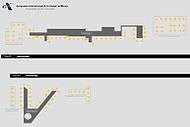

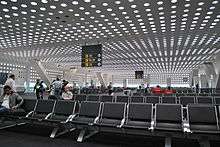
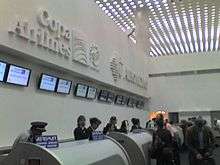


%2C_Aeromexico_JP5930061.jpg)
.jpg)
.jpg)
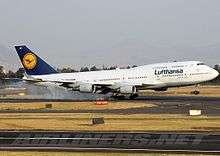
Terminals
Mexico City International Airport has two passenger terminals. Terminal 1 is separated from Terminal 2 by the runways.
Terminal 1
- Opened in 1958; expanded in 1970, 1989, 1998, 2000 and 2004
- Overall terminal surface: 542,000 m2 (5,830,000 sq ft)
- Contact positions: 33
- Two contact positions equipped for the Airbus A380
- Remote positions: 17 (34 Before New T2 was built)
- Number of jetways: 33
- Number of airside halls: 10
- Number of landside (check-in) halls: 9
- Number of mobile-lounges: 11
- Hotel service:
- 600 room Camino Real
- 288 room Courtyard by Marriott
- 327 room Fiesta Inn by Fiesta Americana (Located across from Terminal 1)
- 110 room Hilton
- Parking service: 3,100 vehicles (Domestic), 2,400 vehicles (International)
- Space per passenger in T1: 17 m2 (180 sq ft)
- Number of baggage claim carousels: 22
Terminal 1 is currently the largest airport terminal in the Americas and the fourth largest in the world.
Terminal 2
- Opened in 2007
- Overall terminal surface: 288,000 m2 (3,100,000 sq ft)
- Contact positions: 23
- Remote positions: 18 (Aeromar and Aeroméxico Connect)
- Number of jetways: 23
- Number of airside halls: 2 (Domestic, International)
- Number of landside (check-in) halls: 3 (L1, L2, L3)
- Hotel service:
- 287 room NH
- Parking service: 3,000 vehicles
- Space per passenger in T2: 22 m2 (240 sq ft)
- Number of baggage claim carousels: 15)
- Platform surface: 426,000 m2 (4,590,000 sq ft)
- Inter-terminal Aerotrén capacity: 7,800 daily passengers
Terminal 2 was built over a surface area of 242,666.55m² and has modern security systems, in accordance with international standards including a passenger traffic separation systems. The new facility will help AICM increase its capacity to 32 million passengers per year.
Air operations in the new facilities began on November 15, 2007, with flights by Aeromar and Delta Air Lines, and later AeroMéxico, Copa, LAN and Continental Airlines. Terminal 2 was formally inaugurated by former Presidente Felipe Calderón Hinojosa on March 26, 2008.
These projects were done without affecting airplane takeoffs and landings, and will help Mexico City International Airport offer better services, and respond to the growing demand of passengers and operations in the coming years.
Terminal 2 now houses all Aeroméxico flights out of the airport, becoming the airline's main distribution center. Although the terminal was intended to be served by all-SkyTeam member airlines, Air France and KLM decided to remain at Terminal 1.
Other facilities
Aeropuertos y Servicios Auxiliares, a government-owned corporation that operates airports in Mexico, has its headquarters on the airport property.,[38] Aeropuertos y Servicios Auxiliares.[39] The Aeromar headquarters are located in Hangar 7 in Zone D of the General Aviation Terminal of the airport.[40][41] Aviacsa had its headquarters in Hangar 1 in Zone C, but ceased operations on May 4, 2011.[42]
Airlines and destinations
The airport connects 52 domestic and 50 international destinations in Latin America, North America, Europe and Asia. Aeromexico serves the largest number of cities from any Latin American hub (80), 46 domestic and 34 international.[43] Most prominent foreign airlines are United Airlines, American Airlines, Delta Air Lines and Avianca Holdings. Aeroméxico/Aeroméxico Connect operates the most departures from the airport followed by Interjet, Volaris, and Aeromar. Aeroméxico also operates to the most destinations followed by Interjet. In peak season, Iberia, Lufthansa and Air France operate the most trans-Atlantic flights (28 flights per week) with nonstop service to Madrid, Frankfurt, Múnich and Paris.
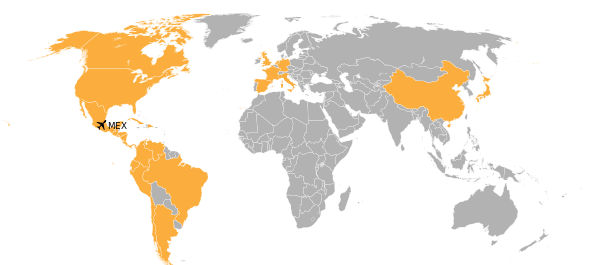
Passenger Airlines
.jpg)
.jpg)
.jpg)
.jpg)
.jpg)
.jpg)
This table lists passengers flights served with a nonstop or direct flight with no change of aircraft carrying passengers originating in Mexico City according to the airlines' published schedules, unless otherwise noted.
Other Services
In addition to the scheduled airlines above, Mexico City airport is used by some further airlines for chartered flights including:
Cargo Airlines
%2C_Cargolux_Airlines_International_JP6047248.jpg)
.jpg)
As of January 2016, Mexico City airport is served by 19 cargo airlines flying directly to Europe, Central, North and South America, Middle East and East Asia. The following airlines operate the scheduled destinations below.
Airlines providing on-demand cargo services
- Aeronaves TSM
- Air Cargo Carriers
- Air Transport International
- Ameristar Air Cargo
- Atlas Air operated by Panalpina
- Cielos Airlines
- Florida West International Airways
- IFL Group operated by Contract Air Cargo
- Kalitta Air
- LAN Cargo
- Líneas Aéreas Suramericanas
- USA Jet Airlines
- Vigo Jet
- World Airways
Traffic statistics
In 2015, Mexico City International Airport moved 38,433,078 passengers. It was the busiest airport in the country and the 2nd busiest in Latin America in terms of total passengers, an increase of 12.2% since last year and 60% since 2010.[7] It was the biggest growing airport in Latin America during 2015 by net traffic, with an increase of over 4.5 million passengers.[52]
In terms of international passengers, it was the third-busiest airport in Latin America with 12,758,456 passengers,[4] behind São Paulo-Guarulhos (13,620,000),[53] Cancún (13,566,003)[54] and the second busiest in Mexico after Cancún.
The airport is the busiest in Mexico and Latin America by aircraft movements with 24% more operations than Bogotá-El Dorado[55] and 44.65% more than São Paulo-Guarulhos.[53] It is the 15th busiest airport in the world in terms of aircraft departures.[56] For the 12-month period ending September 30, 2016, the airport handled 442,559 aircraft operations, an average of 1,212 operations per day.
Regarding cargo, the airport is also the busiest in the country and the second busiest in Latin America, after El Dorado International Airport[55] in Bogotá. During 2015, it moved over 446,915 tons, an annual increase of 12.5%. The net growth of almost 50,000 tons was the biggest in the region.[52]
 |
| Updated: January 30, 2016. |
|
|
| Year | Domestic | % change | International | % change | Total | % change |
|---|---|---|---|---|---|---|
| 2016 (Jan-Sep) | 65,670.69 | 285,919.33 | 351,590.02 | |||
| 2015 | 82,100.42 | 364,814.69 | 446,915.11 | |||
| 2014 | 67,341.85 | 331,214.62 | 398,556.47 | |||
| 2013 | 63,678.54 | 312,911.31 | 376,589.85 | |||
| 2012 | 78,666.10 | 318,351.98 | 397,018.08 | |||
| 2011 | 81,953.37 | 329,502.22 | 411,455.59 | |||
| 2010 | 84,846.88 | 308,228.992 | 393,075.87 | |||
| 2009 | 83,999.43 | 237,134.01 | 321,133.44 | |||
| 2008 | 97,070.08 | - | 279,025.63 | - | 376,095.71 | - |
Top Destinations
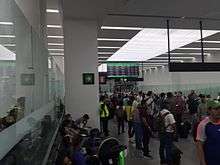
|
|
|
|
Inter-terminal transportation

Terminal 1 is connected to Terminal 2 by the Aerotrén monorail system in which only connecting passengers with hand baggage are allowed to use with their boarding pass. Technical and cabin crew can also use it. The distance between the terminals is 3 km (1.9 mi). and the Airtrain's speed is 45 km/h (28 mph). Also there is a land service between terminals called "inter-terminal transportation". These buses are located at entrance no. 6 of Terminal 1 and entrance no. 4 of Terminal 2.
Ground transportation
Metro and bus services
Terminal 1 is served by the Terminal Aérea Metro station, which belongs to Line 5 of the subway, running from Pantitlán station to Politécnico station. It is located just outside the national terminal. Also, trolley bus line G runs from the bus stop next to the Metro to Boulevard Puerto Aéreo station 1.7 km (1.1 mi) away, allowing transfer to Metro Line 1 (one can also take line 5 to Pantitlán and change to line 1, which is a geographical detour). Terminal 2 does not have any Metro station, but is a 700 m (2,300 ft) walk from Pantitlán served by Metro lines 1, 5, 9, A and numerous local buses.
Terminals 1 and 2 have two land terminals operating 24 hours a day, 365 days a year. Different bus lines operate from here , and provide continuous transportation services to the main cities located around Mexico City, such as Córdoba, Cuernavaca, Pachuca, Puebla, Querétaro, Tlaxcala and Toluca.
Metrobús
In late 2010, former Head of Government of the Federal District Marcelo Ebrard announced a plan to build a new Metrobús Line 4 that would run from near Buenavista Station in the west of the city towards Mexico City airport. Construction on Line 4 started on July 4, 2011. The plans for Line 4 include a two step construction process with the first 28 km (17 mi) operational segment to be built between Buenavista and Metro San Lázaro. An extension provides travel between San Lázaro and the airport. The line opened on April 1, 2012.
| Service | Destinations [departing from the airport] | Operator |
|---|---|---|
| | Metro San Lázaro, TAPO bus station, Historic Centre, Metro Buenavista, Buenavista Station | |
Authorized taxis
Taxis are in operation in Terminals 1 and 2 and there are two models of service: Ordinary service in a sedan type vehicle for 4 passengers. Executive service in 8 passengers vans. At present there are 5 taxi groups in operation. These are the only taxis authorized by the Ministry of Communications and Transport (SCT) of the Federal Government.
Accidents and incidents
- On April 10, 1968, an Aerovías Rojas Douglas R4D-3 crashed on approach, killing all eighteen people on board. The aircraft was operating a domestic scheduled passenger flight, which was the airline's inaugural flight from Aguascalientes International Airport to Mexico City.[61]
- On October 31, 1979, Western Airlines Flight 2605 crash-landed. The crew of the DC-10 landed on a closed runway and hit construction vehicles on the runway. There were 73 fatalities (including one on the ground) and 16 survivors.[62][63]
- On December 12, 1981, a bomb exploded inside the passenger cabin of a parked Aeronica Boeing 727-100, tearing a hole into the fuselage. The captain, two flight attendants and a ground worker were injured. They had been on board the aircraft for pre-departure checks for a scheduled passenger flight to San Salvador and onwards to Managua's Augusto C. Sandino International Airport.[64]
- An Aero California DC-9-15 overran a runway on July 21, 2004, during an intense storm at the airport. There were no victims, but the aircraft was scrapped. However, a woman died later due to a heart attack.[65]
- On November 4, 2008 a Mexican Interior Ministry LearJet 45 crashed on approach around 18:45 local time. On board were Mexican Secretary of the Interior Juan Camilo Mouriño, who was top aide to President Felipe Calderón. Mouriño was in charge of the fight against the drug trade in Mexico. Also on board was José Luis Santiago Vasconcelos, former assistant attorney general and current head of the federal technical secretariat for implementing the recent constitutional reforms on criminal justice and public security. All eight on board perished along with eight others on the ground. 40 others on the ground were injured. The crash was attributed to pilot error.[66]
- On September 9, 2009, hijacked Aeroméxico Flight 576 landed at Mexico City International Airport from Cancún International Airport.[67]
- On September 13, 2009, a Lufthansa Cargo McDonnell-Douglas MD-11 was damaged in a heavy landing. Post landing inspection revealed that there were wrinkles in the fuselage skin and the nose gear was bent.[68] According to a Lufthansa spokesman, the aircraft will be repaired and returned into full service.[69]
- On June 25, 2012, two federal police officers who were stationed at the airport opened fire at colleagues who were surrounding them and were about to arrest them after an investigation showed they were involved in drug trafficking offenses. Two federal police officers were killed at the scene and a third officer died later at a local hospital. The suspects were able to flee the scene, but their identities are known. Operations at the airport were not affected.[70]
See also
References
- 1 2 "Benito Juárez International airport - Economic and social impacts". Ecquants. Retrieved September 7, 2013.
- ↑ Airport information for MMMX at World Aero Data. Data current as of October 2006.Source: DAFIF.
- ↑ Airport information for MEX at Great Circle Mapper. Source: DAFIF (effective October 2006).
- 1 2 3 "AICM Statistics (in Spanish)". AICM.
- ↑ "ASA's airport network (In Spanish)". ASA. July 2014. Retrieved 2014-07-28.
- ↑ "TLC and alternate airport for Mexico City (In Spanish)". El Universal. Retrieved March 29, 2015.
- 1 2 "Statistics Mexico City airport" (PDF). Mexico City International Airport. Retrieved January 13, 2015.
- ↑ Lagorio, Juan José (February 14, 2014). "Canaero to propose plan to ease Mexico City Airport saturation". BN Americas. Archived from the original on March 29, 2015.
- ↑ "New Mexico City International Airport (In Spanish)". Presidency of the Republic. Retrieved September 7, 2014.
- ↑ "Mexico unveils Norman Foster design for new international airport". The Guardian. September 3, 2014. Archived from the original on September 6, 2014.
- ↑ "Unplanned airport planning in Mexico City". Academia Education. Retrieved September 8, 2014.
- ↑ "Disgruntled neighbors by noise pollution in Mexico City". Quadratin. Retrieved September 8, 2014.
- ↑ "Mexican-americans in aviation online exhibition". San Diego Air & Space Museum. Retrieved September 7, 2014.
- ↑ "Conquistador of the Sky: A History of Aviation in Latin America". Project MUSE. Retrieved September 7, 2014.
- ↑ "Mexico's 100 years of flying taking off to new heights!". The Catalist. Retrieved September 7, 2014.
- ↑ "A brief Mexican History aviation". Mexconnect. Retrieved September 7, 2014.
- ↑ "One more year of Mexico City International Airport (In Spanish)". Contenido. Retrieved September 7, 2014.
- ↑ "Breve Historia del Aeropuerto Internacional de la Ciudad de México", Mexico City International Airport
- 1 2 "Historia de la aviación en México (in Spanish)". Colegio de Pilotos de México. Retrieved 2016-01-26.
- ↑ Obras. Retrieved June 4, 2015.
- ↑ "A New Airport for Mexico City?". MexDFmagazine. Retrieved June 4, 2015.
- ↑ Historic photo at FlyAPM site
- ↑ "Sistema Aeroportuario de la Ciudad de México (in Spanish)". Esquinca, Rosique. May 25, 2013. Retrieved 2016-02-03.
- ↑ "DECRETO que establece el cierre del Aeropuerto Internacional de la Ciudad de México Benito Juárez (in Spanish)". Diario Oficial de la Federación. January 13, 1994. Retrieved 2016-02-03.
- ↑ "Iniciaría en febrero la ampliación del AICM (in Spanish)". El Universal. January 3, 2000. Retrieved 2016-02-03.
- ↑ "Mexico drops planned airport after protests from peasants". The New York Times. Retrieved September 7, 2014.
- ↑ Elizalde, Triunfo; Vargas, Rosa Elvira (October 5, 2006). "Decretará Fox que el AICM se denomine Benito Juárez" [President Vicente Fox decrees official name for Mexico City Airport] (in Spanish). La Jornada. Archived from the original on September 8, 2014.
- ↑ "Mexico City inaugurates new airport terminal". USA Today. Retrieved September 7, 2014.
- ↑ "DECLARATORIA de saturación en el campo aéreo del Aeropuerto Internacional de la Ciudad de México (in Spanish)". Diario Oficial de la Federación. 2014-09-29. Retrieved 2016-01-26.
- ↑ "Lack of capacity in Mexico City spurring growth in regional airports". BNamericas. 2015-05-24. Retrieved 2016-02-02.
- ↑ "Simulating Airport Capacity: Mexico City Airport Case" (PDF). E.E Mendoza Dorantes et al, Delft University of Technology. Retrieved 2016-02-03.
- ↑ "New Mexico City International Airport". CAPA Centre for Aviation. Archived from the original on September 6, 2014.
- ↑ Gomez, Veronica; Stargardter, Gabriel (September 4, 2014). "UPDATE 1-Mexico eyes foreign builder, local partners for $9 bln airport". Reuters. Archived from the original on September 5, 2014.
- ↑ Uphoff, Rainer (September 4, 2014). "Mexico to open new mega airport in 2018". Flightglobal. Madrid. Archived from the original on September 5, 2014.
- ↑ "Ready for landing: Mexico City airport expansion could make it one of largest in world", Christian Science Monitor, 2014-09-03
- ↑ Luhnow, David (September 2, 2014). "Mexico Plans New $9.2 Billion Airport". The Wall Street Journal. (subscription required)
- ↑ Alissa Walker. "Mexico City's New Mega-Airport Will Collect Its Own Energy and Water". Gizmodo. Gawker Media. Retrieved June 4, 2015.
- ↑ "ASA's address". Aeropuertos y Servicios Auxiliares. Retrieved September 6, 2014.
- ↑ Retrieved on December 20, 2011. "Av.602 No.161 Col.Zona Federal Aeropuerto Internacional Ciudad de México Delegación Venustiano Carranza, C.P.15620, México D.F."
- ↑ "Directory: World Airlines." Flight International. March 16–22, 2004. 50. "Hangar 7, Zona "D", Terminal de Aviacion General, Col Federal, Mexico DF, 15620, Mexico"
- ↑ "Aeromar headquarters and Customer Service Center". Aeromar. Retrieved September 6, 2014.
- ↑ "Directorio." Aviacsa. Consulted on January 23, 2011. "DIRECCIÓN COMERCIAL Hangar 1, Zona "C", Col. Aviación Gral. [...] Aeropuerto Int. de la Cd. de México. C.P. 15520 (in Spanish)"
- ↑ Aeromexico, The Airline Serving The Largest Number Of Cities From A Hub In Latin America
- ↑ "ANA schedules Mexico launch in Feb 2017". routesonline. Retrieved 10 November 2016.
- ↑ "Going Out: Mexico City International Airport- Las Vegas". interjet.com. Retrieved September 15, 2016.
- ↑ "Southwest ends Orange County – Mexico City operation in Jan 2017" (Web). Routes Online. Retrieved October 18, 2016.
- 1 2 3 4 "Volaris announces new routes to United States (in Spanish)". EnElAire. October 2016. Retrieved October 12, 2016.
- ↑ "Cathay Pacific expands presence in Latin America with new freighter service to Mexico City". Cathay Pacific. Retrieved September 5, 2014.
- ↑ "Emirates SkyCargo launches freighter service to Mexico City and Atlanta". Emirates SkyCargo. Retrieved September 5, 2014.
- ↑ "Qatar Airways Cargo to launch freighter services to Los Angeles". Qatar Airways. Retrieved March 26, 2015.
- ↑ "Qatar Airways Cargo to launch dedicated service to Mexico". Qatar Airways. Retrieved September 5, 2014.
- 1 2 "Preliminary data points to growth of over 6% in accumulated passenger traffic for 2015; air freight volumes in positive territory". Airports Council International. Retrieved February 16, 2016.
- 1 2 "Guarulhos airport statistics by international passengers". Guarulhos International Airport. Retrieved February 3, 2016.
- ↑ "ASUR Announces Total Passenger Traffic for December 2015 Up 8.5% Year over Year".
- 1 2 "Bogota airport statistics". Bogota International Airport. Retrieved February 3, 2016.
- ↑ http://www.icao.int/sustainability/Documents/MonthlyMonitor-2016/MonthlyMonitor_February2016.pdf
- ↑ "Statistics Mexico City Airport". Mexico City International Airport. Retrieved August 13, 2016.
- 1 2 "Air carrier operational statistics". Secretariat of Communications and Transportation (Mexico). Archived from the original on January 5, 2016. Retrieved January 31, 2015.
- ↑ "Air carrier operational statistics". Secretariat of Communications and Transportation (Mexico). Retrieved January 30, 2016.
- ↑ "Air carrier operational statistics". Secretariat of Communications and Transportation (Mexico). Retrieved September 5, 2014.
- ↑ "XA-GEV Accident description". Aviation Safety Network. Retrieved July 24, 2011.
- ↑ "WA2605 Accident description". Aviation Safety Network. Retrieved September 4, 2014.
- ↑ "Flight WA2605 crash photo". Air Disaster. Retrieved September 4, 2014.
- ↑ "Commercial airline bombing history". Aerospaceweb. Retrieved September 6, 2014.
- ↑ "XA-BCS Accident description (in Spanish)". La Jornada. Retrieved September 4, 2014.
- ↑ "Plane crash kills Mexico's deputy leader". Time. Retrieved September 4, 2014.
- ↑ "Bolivian man acted alone in Mexico hijacking.". CNN. Retrieved September 4, 2014.
- ↑ "Accident: Lufthansa Cargo MD11 at Mexico City on Sep 13th 2009, hard landing". The Aviation Herald. Retrieved October 11, 2009.
- ↑ "Lufthansa Cargo wird D-ALCO in Stand setzen" (in German). aero.de/Aviation Media & IT. Retrieved October 24, 2009.
- ↑ "Rogue police officers kill 3 colleagues at Mexico City airport". BNO News. June 26, 2012. Retrieved June 26, 2012.
External links
| Wikimedia Commons has media related to Mexico City International Airport. |
| Wikivoyage has a travel guide for Benito Juárez International Airport. |
- Mexico City International Airport
- Aeropuertos y Servicios Auxiliares (Spanish)
- Information about Mexico City Airport
- Accident history for MEX at Aviation Safety Network
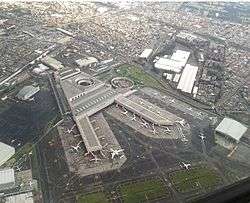
.jpg)
.jpg)